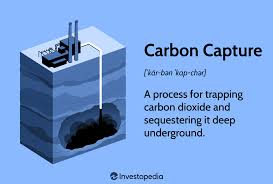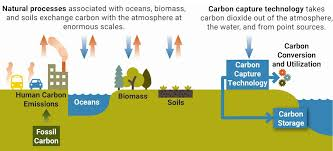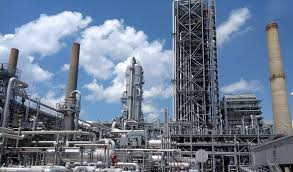CARBON CAPTURE AND STORAGE
Carbon Capture and Storage (CCS) is a technology that aims to mitigate climate change by capturing carbon dioxide (CO2) emissions from large industrial sources like power plants, transporting it, and then storing it deep underground in geological formations, effectively preventing it from entering the atmosphere and contributing to global warming; this process involves capturing CO2 at the point of emission, transporting it via pipelines, and finally storing it in suitable deep geological formations like depleted oil and gas reservoirs or saline aquifers.
Key points about CCS:
- Process:The three main steps of CCS are: capturing CO2 from flue gases at the source, transporting it to a storage site, and injecting it deep underground for long-term storage.
- Benefits:CCS can significantly reduce CO2 emissions from fossil fuel-based power plants and industries, potentially playing a crucial role in achieving climate change mitigation goals.
- Challenges:Major challenges include the high cost of capturing CO2, finding suitable storage sites, and ensuring long-term storage stability.
- Application areas:Power generation from fossil fuels (coal, gas), industrial processes like cement production, and potentially direct air capture (removing CO2 directly from the atmosphere).
KEY TECHNOLOGIES:
Carbon capture and storage (CCS) technologies include post-combustion capture, direct air capture (DAC), and oxy-fuel combustion. These technologies capture carbon dioxide (CO2) from power plants, industrial facilities, and the atmosphere. The captured CO2 is then stored underground or used in other applications.
Post-combustion capture
- Uses chemical or physical adsorption to capture CO2 from the exhaust gases of power plants
- Can be retrofitted to existing power plants
- Monoethanolamine (MEA) is the most common chemical absorption technique used in commercial facilities
Direct air capture (DAC)
- Uses air filters to capture CO2 directly from the atmosphere
- Expensive and still in its early stages
- Has potential to reduce carbon emissions from the atmosphere
Oxy-fuel combustion
- Burns fuel in pure oxygen instead of air, which reduces NOx emissions
- Has higher efficiency than air-fired combustion
- Has higher flame temperatures, high costs, and high energy consumption for oxygen production
CCS technologies are part of a wider set of techniques called carbon dioxide removal (CDR) or negative emissions techniques (NETs).

ADVANTAGES AND DISADVANTAGES OF CCS:
Carbon capture and storage (CCS) has both advantages and disadvantages.
Advantages
- Mitigates climate change: CCS can help reduce greenhouse gas emissions.
- Reduces emissions from major sources: CCS can capture CO2 from large sources like power plants and manufacturing facilities.
- Promising technology: CCS could reduce emissions in heavy industries by 25–67%.
Disadvantages
- High cost: CCS costs vary based on the type of technology, industry, and concentration of CO2.
- Energy intensive: CCS requires a lot of energy to power the capture process.
- Environmental risks: CCS can have environmental risks.
- Limited scale: CCS deployment on a large scale can be challenging.
How does CCS work?
CCS involves capturing CO2 from industrial processes, transporting it, and storing it underground in geologic formations. The CO2 can be captured before or after combustion.
Other carbon capture technologies:
- Direct air capture (DAC): DAC technologies can extract CO2 from the atmosphere at any location.
- Enhanced oil recovery (EOR): EOR uses CO2 to help pump out oil that would otherwise be unreachable.

USES OF CCS:

Carbon Capture and Storage (CCS) is primarily used to mitigate climate change by capturing carbon dioxide emissions from industrial processes and power plants, then transporting and storing it underground in deep geological formations like depleted oil and gas reservoirs, coalbeds, or saline aquifers, effectively preventing its release into the atmosphere; this is considered a key technology for reducing greenhouse gas emissions and combating climate change.
Key points about CCS usage:
- Major emission sources: CCS is most commonly applied to large point sources of CO2 emissions like coal-fired power plants, cement factories, and natural gas processing plants.
- Capture methods: Carbon dioxide is captured from flue gases using various technologies like amine scrubbing, membrane separation, or oxyfuel combustion, which essentially produces a concentrated stream of CO2.
- Transportation: The captured CO2 is compressed into a liquid state and transported via pipelines, ships, or trucks to the storage site.
- Storage mechanisms: Once transported, the CO2 is injected deep underground into suitable geological formations where it is trapped due to pressure and geological conditions.
Potential additional uses of captured CO2:
- Enhanced Oil Recovery (EOR): Injecting captured CO2 into depleted oil reservoirs can increase oil extraction by displacing remaining oil.
- Carbon utilization: Research is ongoing to utilize captured CO2 as a feedstock for producing chemicals, synthetic fuels, or carbon-neutral concrete.
Important considerations regarding CCS:
- High energy demand: The process of capturing and compressing CO2 can be energy-intensive, requiring careful design and optimization to minimize energy consumption.
- Storage site selection: Finding suitable geological formations with adequate storage capacity is crucial for long-term carbon sequestration.
- Cost effectiveness: Implementing CCS on a large scale can be costly, and government incentives may be necessary to encourage its adoption.


